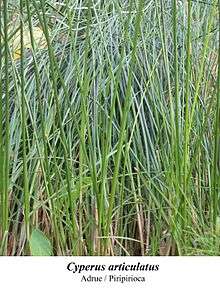Cyperus articulatus
Cyperus articulatus is an aromatic species of sedge known by the common names jointed flatsedge and priprioca. It has also been known as Guinea rush or adrue.[3] It grows as a perennial[4] herb.[5] It grows in water or near it in rivers, streams, lakes, and swamps with a hyperhydrate (emergent aquatic) or possibly tenagophyte (submerged juvenile and terrestrial adult) growth pattern.[4] It is widespread across tropical and subtropical regions in Africa, southern Asia,[4] northern Australia, the southeastern United States, the West Indies, and Latin America.[6][5] While it is closely related to highly invasive sedges such as purple nut sedge (Cyperus rotundus), priprioca is less prolific and competitive than its relative.
| Cyperus articulatus | |
|---|---|
 | |
| Cyperus articulatus | |
| Scientific classification | |
| Kingdom: | Plantae |
| Clade: | Tracheophytes |
| Clade: | Angiosperms |
| Clade: | Monocots |
| Clade: | Commelinids |
| Order: | Poales |
| Family: | Cyperaceae |
| Genus: | Cyperus |
| Species: | C. articulatus |
| Binomial name | |
| Cyperus articulatus L. 1753 | |
| Synonyms[2] | |
|
List
| |
Description
It is similar in appearance to C. corymbosus but with terete culms with 5–20 mm long intersepta and is transversely septate. Its leaf blades are completely absent and it has scale-like involucral bracts measuring less than 15 mm long. The anthers are 1.0-1.5 mm long and the floral glumes are 2.25 to 3.5 mm in length.[4]
| Number of chromosomes | 56 [7][8] |
|---|
Uses
Related to other nut sedges (such as tigernut), priprioca roots release a light, woody, and spicy fragrance with floral notes. It is one of the traditional spices of the Amazon region, used medicinally in local tradition, and its reddish essential oil is used commercially both by the cosmetic industry, and increasingly as a flavoring for food.[9][10]
Like its relative papryus, priprioca fibers and rhizomes are also used in crafts,[5] since in addition to the exuberant perfume, the products are resistant to mold, possibly indicating that the essential oil has antifungal properties. Among its main components are muskatone, alpha-Pinene, beta-Pinene, caryophyllene oxide, trans-pinocarveol, myrtenal, myrtenol, ledol, cyperotundone, and alpha-cyperone, though the oil is very complex and no single element plays a dominant role over the others. According to local Amazonian medical tradition, priprioca may be harmful to pregnant women, adverse effects possibly including miscarriage.[11]
In Folklore
According to Brazilian folklore,[12] the name priprioca came from Piri-Piri, a major warrior who lived in an indigenous village in the heart of the Amazon rainforest. It is said that he gave off a wonderful smell, able to attract any indigenous tribe. He also had the power to disappear when in danger, or to get rid of the hordes of girls at his feet. Once, the daughter of a shaman named Supi was desperately in love with Piri-Piri. She asked her father to teach her a spell to capture Piri-Piri. The shaman then told her to tie Piri-Piri's feet with her hair on a full moon night. Sensing danger, Piri-Piri disappeared in a cloud, never to return. In the place where the warrior was last seen, a plant sprouted which also gave off his magnificent aroma; in his honor, this plant was named piripirioca, later shortened to priprioca.
References
- Gupta, A.K., Mahamane, A., Diop, F.N., Beentje, H.J., Ben Saad, S., Daoud-Bouattour, A., Ghrabi, Z. & Muller, S. 2017. Cyperus articulatus. The IUCN Red List of Threatened Species 2017: e.T164147A85693033. https://dx.doi.org/10.2305/IUCN.UK.2017-1.RLTS.T164147A85693033.en. Downloaded on 12 September 2017.
- The Plant List (2013). Version 1.1. Published on the Internet; http://www.theplantlist.org/tpl1.1/record/kew-235716 Archived 2019-05-17 at the Wayback Machine (accessed 12 September 2017).
- Wren, R.C. (1923). Potter's Cylopedia of Botanical Drugs and Preparations. London: Potter & Clark. p. 4.
- Cook, Christopher D. K. (28 March 1996). "Cyperaceae". Aquatic and Wetland Plants of India: a reference book and identification manual for the vascular plants found in permanent or seasonal fresh water in the subcontinent of India south of the Himalayas. New York, NY: Oxford University Press. p. 105. ISBN 9780198548218. OCLC 32968513.
- Uphof, Johannes Cornelis Theodorus (1968) [1959]. Dictionary of Economic Plants (second ed.). New York, NY: J. Cramer. p. 169. ISBN 9783904144711. OCLC 48693661.
- Kew World Checklist of Selected Plant Families
- Sarkar, A. K.; Chakraborty, M.; Saha, N. C.; Das, S. K. (November 1976). Löv, Áskell (ed.). "IOPB Chromosome Number Reports LIV". Taxon. 25 (5): 631–649. doi:10.1002/j.1996-8175.1976.tb03496.x. ISSN 0040-0262. JSTOR 1220124. OCLC 5550786521.
CYPERACEAE Cyperus articulatus L. n = 56. India: W. Bengal, Dankuni, Hooghly. CBLH 13322.
- Feinbrun, Naomi; Lerman-Shadder, Shlomith (November 1985). Löve, Áskell (ed.). "Chromosome Number Reports LXXXIX". Taxon. 34 (4): 727–730. doi:10.1002/j.1996-8175.1985.tb04449.x. ISSN 0040-0262. JSTOR 1222236. OCLC 5556848342.
Cyperus articulatus L. n = 56-57. Jerusalem, University Garden. Lerman C.03.59.
- Atala, A. (2012). "A new ingredient: The introduction of priprioca in gastronomy". International Journal of Gastronomy and Food Science. 1: 61–81. doi:10.1016/j.ijgfs.2011.11.001.
- Natura. "Perfumes baseados em Priprioca". Archived from the original on 2009-04-03.
- Azambuja, Wagner. "Priprioca Essential Oil - Óleos Essenciais O Guia do Brasil". Óleos Essenciais. Brazil. Archived from the original on 13 September 2017. Retrieved 12 September 2017.
- Luís da Câmara Cascudo (1954). Instituto Nacional do Livro (ed.). Dicionário do folclore brasileiro. Rio de Janeiro.
External links
- USDA Plants Profile
- Flora of North America


